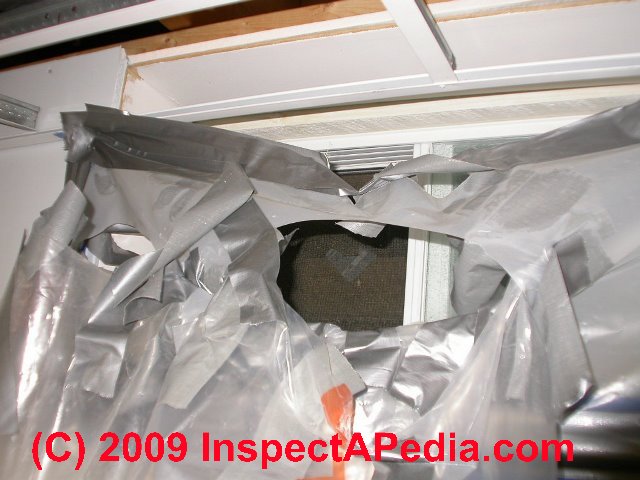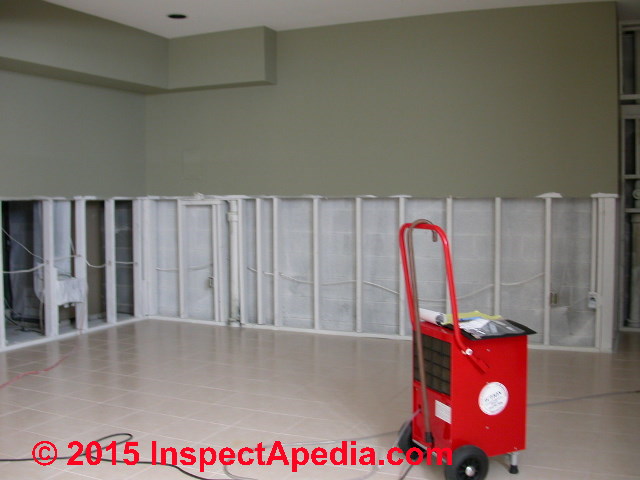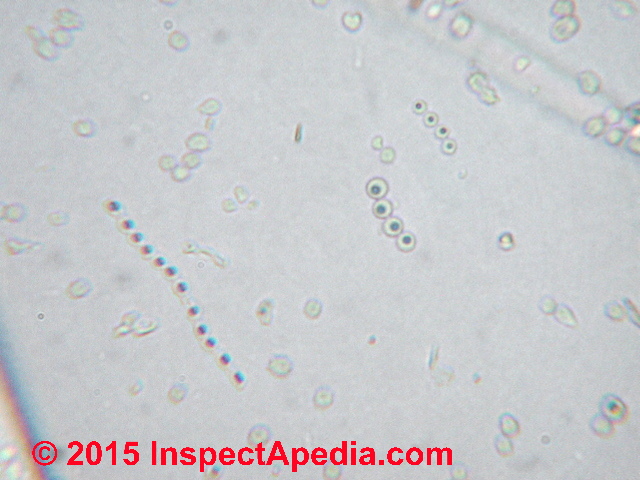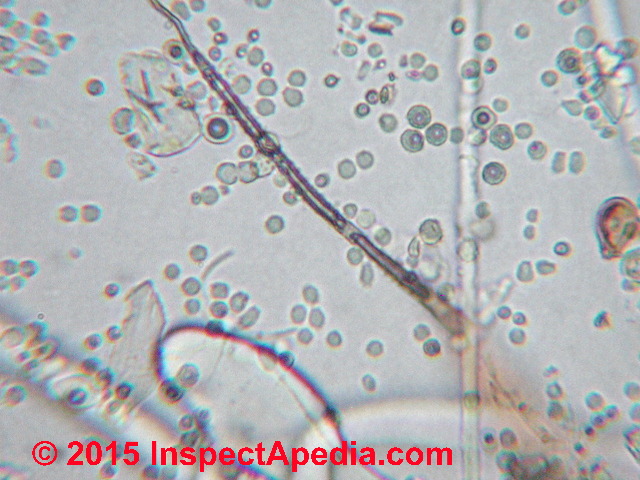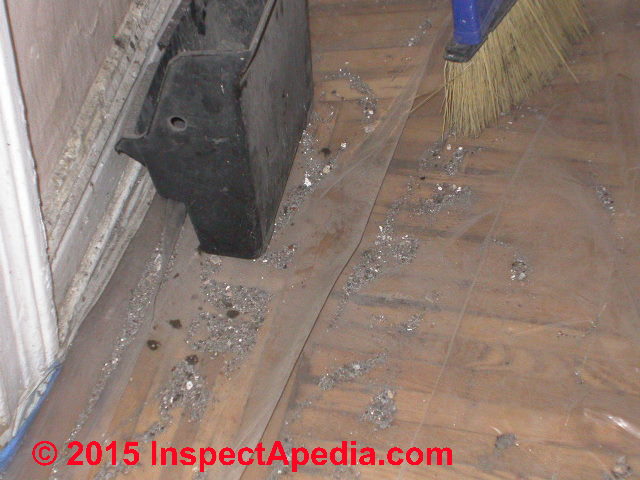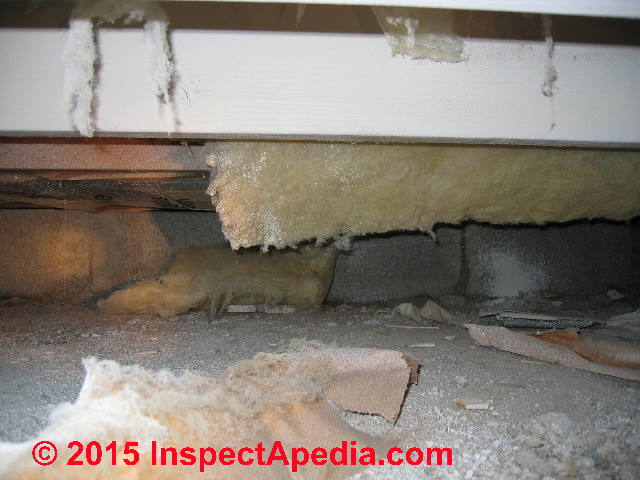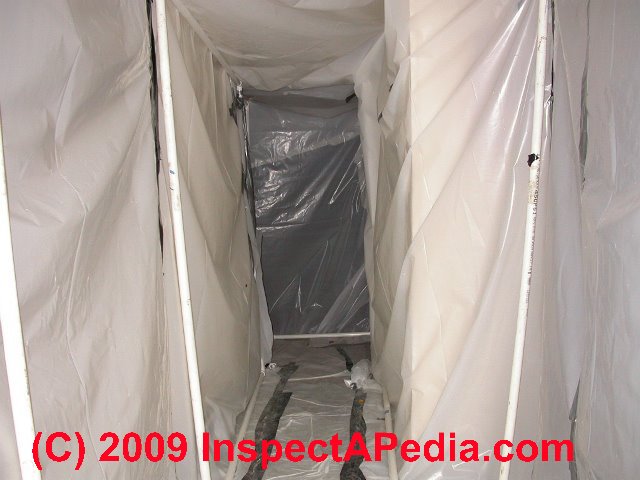 Mold Remediation Job Clearance Timing
Mold Remediation Job Clearance Timing
When to Schedule the Mold Clearance Inspection
- POST a QUESTION or COMMENT about testing & inspecting a building after a mold remediation project
Mold clearance test & inspection timing details:
When to schedule an inspection and testing after a mold cleanup project. Here we explain and describe in more detail the post remediation mold clearance procedures and testing that should be used after a mold remediation or mold cleanup project.
InspectAPedia tolerates no conflicts of interest. We have no relationship with advertisers, products, or services discussed at this website.
- Daniel Friedman, Publisher/Editor/Author - See WHO ARE WE?
When to Inspect & Test a Building After a Mold Cleanup / Remediation Project
 This article is part of our MOLD CONTAMINATION ACTION GUIDE which provides an easy to understand step-by-step guide for dealing with toxic or allergenic indoor mold and other indoor contaminants: what to do about mold "mildew," moisture, in your house or office, building-related illness, involving your physician, treatment, sick building investigators, reduction of irritants, and special products to help clean buildings and air.
This article is part of our MOLD CONTAMINATION ACTION GUIDE which provides an easy to understand step-by-step guide for dealing with toxic or allergenic indoor mold and other indoor contaminants: what to do about mold "mildew," moisture, in your house or office, building-related illness, involving your physician, treatment, sick building investigators, reduction of irritants, and special products to help clean buildings and air.
Daniel Friedman, AIHA, ASHRAE, April 2011 - April 2025
Article Contents
- WHEN to SCHDULE CLEARANCE TESTING
- IMPORTANCE of STILL AIR CONDITIONS
- CLEARANCE TEST PROCEDURES to AVOID
- CLEARANCE TEST with RUNNING AIR SCRUBBERS?
Photo above: my pen points to extensive mold contamination on drywall present after a contractor said that their mold clenaup job was finished.
When mold cleanup is said to be complete, and when the building owner, occupant, or mold remediation contractor has called for a post-remediation clearance "test" we don't expect to see moldy materials still on the job.
...
When to Schedule the Post-Mold-Remediation Clearance Inspection & Tests
As we noted at MOLD CLEARANCE INSPECTIONS and CLEARANCE PROCEDURES, the inspection and testing of a building to confirm that a mold cleanup project (mold remediation) has been adequately performed should not be scheduled until
- After the mold remediation company has completed
all demolition, moldy debris removal, and moldy surface cleanup that are to be performed - After the conditions that caused the mold problem have been corrected (
lest we waste the cost of cleanup by having a new mold problem) - After any building air scrubbers or exhaust systems are off for 24 hours
or more: equipment used during the remediation project should have been turned off for 24-hours or longer (to allow time for dust settlement indoors). See Sill Air Conditions, below. - Before the mold remediation project containment barriers have been removed.
This permits the inspector to evaluate the workmanship of the containment system, its completeness, evidence of failure or collapse.
More, this procedure also means that areas of the building outside the remediation work space remain protected against cross-contamination by moldy dust until the inspection and lab work have confirmed that the cleanup was successful.
Finally, should the inspection or lab work indicate that more cleaning is needed, this process saves the cost of having to re-install containment as well as the possible cost of having to perform extra cleaning outside of the containment area. - Before the remediation area is re-occupied
by people at extra risk from building air quality concerns such as asthmatics, elderly, immune, infants, etc. - While the building remains in still-air conditions:
windows and doors to outside are closed. - Building mechanical systems:
- If weather conditions permit, the building heating or cooling system should be left off to avoid the risk of re-contaminating those systems before the successful clearance has been confirmed.
- An exception may be necessary in cold climates during freezing weather, or in hot humid climates to control humidity.
- HVAC systems serving the remediation area, their air handlers and duct work should be included in clearance inspection and testing, and if clearance includes (as we recommend) checking out of the cleanup area for cross contamination, all building HVAC systems should be included in that procedure.
CONTACT us to suggest changes or additions to this mold clearance inspection protocol.
...
The Role of Still Air Conditions in Post Remediation Mold Clearance Testing
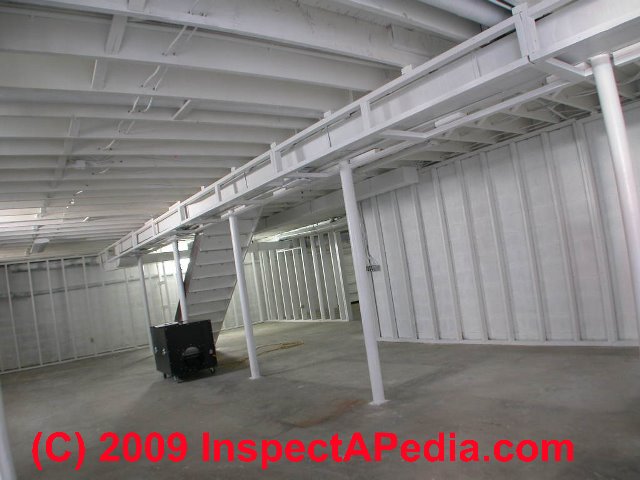 Watch out: Don't Perform Post Mold Remediation Testing Too Soon
Watch out: Don't Perform Post Mold Remediation Testing Too Soon
24-hours of still air conditions is the minimum time we want to allow for settlement of airborne dust and debris in a buildings before conducting an air or surface dust screening test for mold contamination after a mold cleanup project. Longer dust settlement time is better.
Our photo (left) shows a very clean building basement that has been sealed as well. The air scrubber machine remained in the building but as we asked, it had been turned off prior to our onsite inspection.
The containment barriers are not visible in this photo and would need to be verified if only part of the building was being cleaned.
At remediation jobs for which we have been the clearance inspector, we require no less than 24 hours of still air time. The containment is left in place, the air scrubbers are simply turned off.
That allows the clearance inspector to evaluate the quality of dust containment that was set up, and if, as sometimes happens, more cleaning is needed, the containment does not have to be put up a second time, thus saving some money.
And allowing settlement time means that if there was poor cleaning, and the air is still contaminated, we can often find that evidence in settled dust - more reliably than may be found by dashing in and simply grabbing a quick "air sample" (We use both methods).
We have rarely encountered a mold remediation company who objected to our clearance protocol - after all, the more confident everyone can be in the quality of the clearance inspection the more all parties are protected, including the mold remediator. In a few cases in which the remediator wanted us to test while their machines were running (and we have done so) once we explain the issues to the client, that has been the end of any debate on time periods.
Don't Perform Post Mold Remediation Testing Too Late
However, to protect the mold remediation company from being blamed for contamination that may have occurred due to subsequent building leaks or events, or from cross-contamination of the mold remediation work area by mold from other building areas that was excluded from the project (not an exclusion that we recommend), we suggest that
- The post remediation clearance inspection and test be performed before mold containment barriers have been removed.
- The post remediation clearance inspection and test should be performed in not more than five days after the completion of the cleanup project. 24-48 hours is recommended.
- The post remediation inspection should include a report of visible or known conditions at the building that present a risk of future leaks, moisture problems, and mold contamination
...
Post-Mold-Remedation Procedures that are Specifically NOT Recommended Include
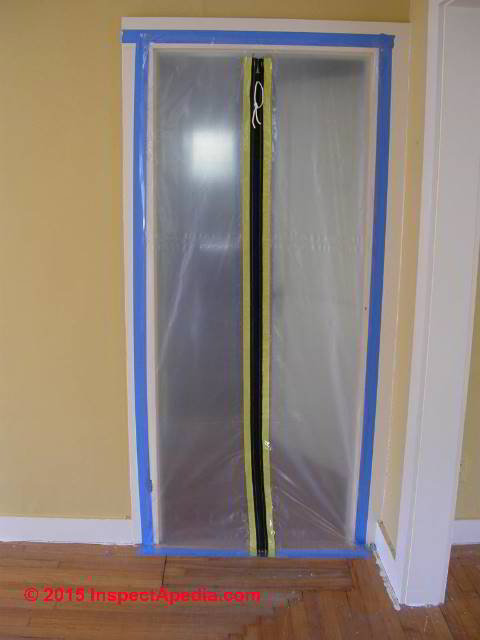 Violating any of the conditions described above
Violating any of the conditions described above
at MOLD CLEARANCE TIMING above.
Taking Down the Containment Barriers Too Soon
At left the mold containment at a doorway has been left in place in an area that has been reported to have been cleaned.
But sometimes the moldy dust containment system has fallen, been punctured, or even removed by the workers when it should have been left in place pending a successful mold cleanup clearance inspection and test.
Our photo (below left) was part of compelling evidence that the mold remediation crew at this New York City apartment cleanup job had been inexperienced to say the least.
The plastic containment barrier had been removed when we arrived to inspect the building.
But we found a number of troubling conditions including
The plastic containment barrier had been "hung" from the fire sprinkler heads using duct tape strips.
Good grief.
What if during the project someone pulls that down and sets off the sprinkler system, creating a new building flood?
What if there is a fire during the project and the sprinkler heads have been tampered-with or blocked?
And why was the ceiling cavity left open to receive dust during demolition, transporting it over other areas of the apartment?
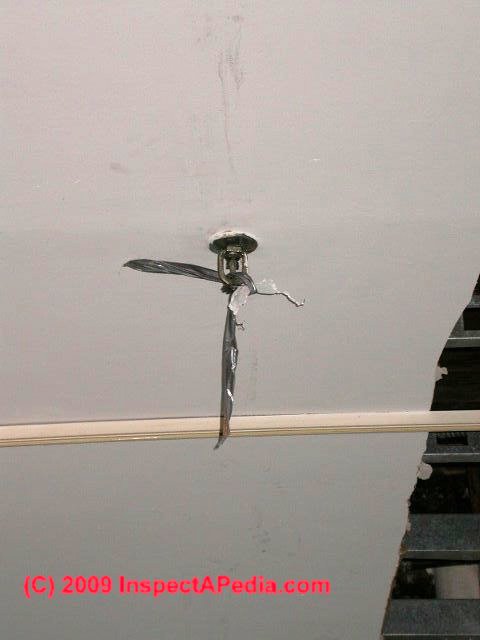
Our second photo (below) shows that the plastic used to seal around an air scrubber exit port had collapsed - probably not a serious failure at this job.
We understand that it can be costly for a mold remediation company to leave equipment idle at a property while waiting for the post-cleanup inspection, testing, lab work, report, and client approval. But that concern should not extend to early removal of the containment system as well.
The temptation to rip down the building containment system before the inspection and clearance test comes from several thoughts in the remediator's viewpoint:
- It seems efficient to take down and dispose of containment while the full remediation work crew is still on site - avoiding having to send laborers back to the jobsite after the clearance test
- The remediation company may be confident (perhaps sometimes overconfident) that their work has been successful
- The remediation company may not want the clearance inspector to evaluate their containment methods, especially where amateur workmanship have been involved.
By premature takedown of the dust containment system risks costs we introduced above.
- It prevents the inspector from supporting the remediation company's workmanship on the containment system by direct observation
- Early containment removal this procedure also means that areas of the building outside the remediation work space remain protected against cross-contamination by moldy dust until the inspection and lab work have confirmed that the cleanup was successful.
- Finally, should the inspection or lab work indicate that more cleaning is needed, this process saves the cost of having to re-install containment as well as the possible cost of having to perform extra cleaning outside of the containment area.
Leaving the Air Scrubbers Running
 Remediators - some - would like you to test while their air machine is running, having the fantasy that even if they didn't remove all the mold they should-have, the scrubber will hide that fact ... until later, after everyone has gone and the remaining mold propagates again.
Remediators - some - would like you to test while their air machine is running, having the fantasy that even if they didn't remove all the mold they should-have, the scrubber will hide that fact ... until later, after everyone has gone and the remaining mold propagates again.
Sometimes this approach - leaving a scrubber on - allows the remediator to shoot themselves in the foot, especially when the company foolishly did not vent the air machine to the outdoors.
In that case if there is problem dust and debris remaining, the machine is simply stirring it up further.
You cannot remove an indoor air particle problem by vacuuming the air. As long as the particle source remains there is, in a practical effect, an infinite particle source.
At left the air scrubber has been un-plugged, which in this case might help the mold remediation contractor from shooting herself in the foot with the loose dirt and debris that had yet to be removed.
The call for a post-remediation mold inspection and test might be premature if you see debris left in the jobsite: if there was enough mold contamination to merit professional cleaning, then that debris is likely to be mold-contaminated.
See our discussion
on CONTINUED USE of AIR SCRUBBERS.
Leaving Building Windows & Doors Open
A second approach that some remediators like is to have the clearance performed while the building is being aggressively ventilated with outdoor air. This too can obscure an in-building remaining mold or particle source problem in or out of the remediation area, and in some conditions can also bring in excessive levels of outdoor pollen or mold. Or moisture, or even rain at an unattended building.
While ventilating a building with outdoor air may work in some cases to help clean up a building interior, it is impossible to distinguish reliably between outdoor conditions and indoor building conditions if the building windows and doors are open 24-hours before or during the clearance inspection.
U.S. EPA Guidance for Mold Clearance Inspection After a Mold Cleanup
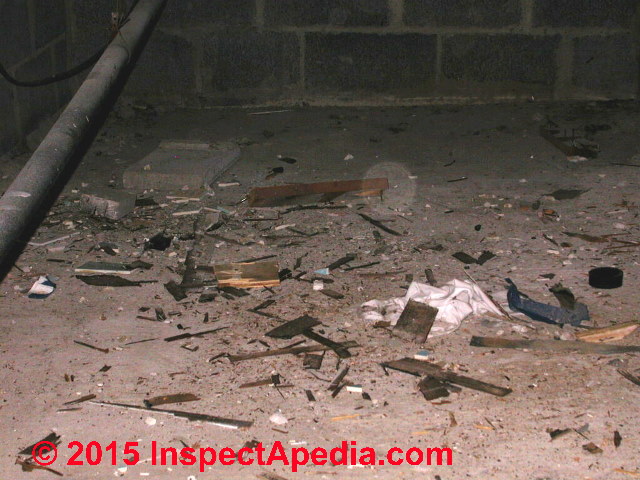 Our complete collection of US and international mold standards references are collected at
Our complete collection of US and international mold standards references are collected at
MOLD EXPOSURE STANDARDS.
From the US EPA we include this more general advice on the criteria for a mold cleanup job: [Our comments are in italics]
How Do I Know When the Remediation or Cleanup is Finished?
- You must have completely fixed the water or moisture problem before the cleanup or remediation can be considered finished.
[See MOLD PREVENTION GUIDE] - You should have completed mold removal. Visible mold and moldy odors should not be present. Please note that mold may cause staining and cosmetic damage.
See MOLD CLEANUP, VISUAL CHARACTERISTICS and see ACCEPTABLE MOLD LEVEL.
Remember that no building is mold-free except perhaps inside of a manufacturing "clean room" - mold exists in air everywhere and small amounts of molds will be found in settled dust just about everywhere - don't set a target of "zero mold".
If the "mold remediation" job has left extensive dirt and debris in the remediation area (photo above left) it is unlikely that the work was successful nor that it was performed by properly-trained professionals. - You should have revisited the site(s) shortly after cleanup and it should show no signs of water damage or mold growth.
See MOLD CLEARANCE TIMING. - People should have been able to occupy or re-occupy the area without health complaints or physical symptoms.
See MOLD RELATED ILLNESS GUIDE - Ultimately, this is a judgment call [and must include an understanding of the original location, extent, type, and cause of mold contamination that was to be removed as well as the chances of other mold contamination in the building that was not addressed];
there is no easy answer.
If you have concerns or questions consult our Frequently Asked Questions database and ask a question [or Contact Us directly at InspectAPedia.com] if you don't find what you need.
...
Continued Use of Negative Air Machines & Air Scrubbers During the Remediation Clearance Inspection & Test?
The following discussion between D.H. and Daniel Friedman, InspectApedia.com editor. We welcome polite argument, comments and suggestions through the page-bottom COMMENTS BOX or by direct email CONTACT Us .
At left, an air scrubber in use at a mold-remediation job that looks (from here) pretty clean. But we do need to look up inside the wall cavity at the back of the remaining drywall.
Betty Crocker Recipe for Remediation is Questionable
I have a question concerning turning off the air scrubbers 24 hours prior to sampling.
Each project is unique and I think remediation protocol needs to be flexible enough to cover the different situations encountered, as long as the efficacy and quality of the job is not compromised.
So, my concern with a general, “Betty Crocker recipe” is this: if you are using the equipment as a negative air machine while remediating, then switching to air scrubbing mode before sampling, you will lose negative pressure differential and increase the chances of cross contamination.
If you use separate equipment for negative air and scrubbing, you are sampling make-up air. I believe there are too many variables on each project to have a general rule covering all situations. You may need to include surface samples of the settled dust when air scrubbers are off.
You could condition make-up air if you maintain negative pressure differentials. Again, the problem is more complex than it initially appears. - Don Hartman, CIEC, Industrial Hygiene,
ALS Life Sciences Division | Environmental, 29 July 2015 by private email
Reply - DJF: Turn off the air scrubbers.
 I agree that post remediation inspection and testing deserve careful thought and that a too-rigid procedure is probably going to make trouble.
I agree that post remediation inspection and testing deserve careful thought and that a too-rigid procedure is probably going to make trouble.
My opinions on this matter derive from both field and lab experience.
"Air Scrubbing" in a typical residential building is something the remediator does hoping to improve the chance of a "pass" on a post remediation air test for mold.
Air testing for mold is fundamentally unreliable as I have amply tested and proven at least to my own satisfaction. A small change in the environment can produce 1-4 orders of magnitude differences in the level of airborne particles.
See ACCURACY OF AIR TESTS for MOLD.
Culture tests, for those inspectors who like swabs or culture plates to "characterize" the mold genera/species present in a building or to count colony forming units, are essentially 90% "wrong" when you open the kit lid.
See MOLD CULTURE TEST KIT VALIDITY.
Furthermore, "scrubbing" air in an environment where the cleanup was incomplete or otherwise inadequate is as futile as trying to vacuum dust bunnies from under the living room couch by standing in the kitchen waving a vacuum cleaner wand in the air.
I and some others want all equipment that is unnecessarily stirring up air turned off 24 hours before a post-remediation inspection in order to
- Represent the conditions that occupants will endure. So I don't want a "false low" because the remediation area is sealed up, air scrubbers are running like mad, but the cleanup was inadequate.
I've seen this condition many times, with visible piles of leftover moldy dirt and debris on floors while the scrubber is scrubbing away. The persistent source had not even been removed. - Permit settled dust sampling
Above the Aspergillus sp. spores in long chains tell us that this mold came from somewhere in the building - it didn't blow in the window from outdoors.
We do not expect to find "zero" mold spores in a cleaned building, though often after an expert and successful mold remediation job the building will be cleaner than a comparable building that has not suffered water leaks, mold damage, and thus mold remediation.
A "zero" mold level report would suggest that the sample was suspect.
Below we see a high level of Aspergillus sp. spores and spore chains in a settled surface dust sample from a mold-remediated surface.
It's important to test a surface that had been wiped quite clean so that we know that the dust we are examining is settling after the mold cleanup job has been completed. With this sort of moldy dust around I'm doubtful that scrubbing the air in the building is going to be very helpful.
We should always be looking at settled dust for dominant particles but at the same time we should not be looking for "zero mold" in the dust samples of a remediated building.
Finally, "testing" without an informed inspection is fundamentally unreliable as well.
"Betty Crocker" I'm not, more like Davey Crockett, intolerant of airborne baloney rather than serving it up in sandwiches.
If you agree I'd like to post your comments and our ongoing discussion at the start of my article series on this
Also see MOLD CLEARANCE INSPECTIONS - home.
and I much welcome further critique or suggestions. - Daniel
Reply - DH:
I would love to hear from some of the people on the front line and their thoughts. These types of conversations are what expands our knowledge and keeps things interesting.
I can certainly see (and in many cases agree) with your approach. It is unfortunate that many times we have to assume that people are chasing money or taking unwarranted shortcuts in order to “pass” the PRV, instead of concentrating on doing a good job. A “good job” is a moving target, involving real-time adjustments during the process. I hope we get some comments on the pros and cons of each side of the issue.
A good start are the questions: “Are there times when the scrubbers should be turned off and other times when they should be left running?” What are the situations that would indicate which action is appropriate?”
I’m looking forward to see what others have to say!
Reply - DJF
Above the remediator had told me the job was ready for a clearance test.
Similarly at above right the crawl space had been "remediated" for mold contamination using the "spray and pray" method. Wet moldy debris remained along with contaminated insulation.
I can't think of any time that scrubbers should be left on for post remediation clearance; rather the remediator should have completed the cleanup. Think of it this way: if on turning off the scrubber the level of airborne contaminants soars then there is a problem that s/he was covering up by continuous scrubbing.
And if turning off the scrubber wouldn't change the results, then what are we worrying about.
I might agree however that negative air handlers need to be kept running as part of a building containment system (in a structure where only part of the building is being treated) until a successful clearance inspection and test are completed. I understand that there are costs involved and sometimes people are hot to use the negative air machines elsewhere or for a smaller remediator, to stop renting them.
But IMO another remediation sin (and one I found committed about half the time on small jobs back when I still did real field work) is to remove or subvert the containment system before the remediation job is passed. You've probably seen some of these disappointing cases: wet building, mold growth, partial mold removal, leak not fixed, new mold growing on "remediated surfaces" visible at the time of the clearance inspection. Ick.
Everyone, including the mold remediation company, is best served by a thoughtful and diligent post-remediation inspection and test procedure that leaves all parties confident that the job has been properly performed. If the post-remediation clearance inspection and test give a green light to the mold cleanup-job that should mean that if in the future actionable mold contamination is found in the building then it must be from a new event and not a left-over un-clean area from the previous job. - DJF
...
Continue reading at ACCEPTABLE MOLD LEVEL or select a topic from the closely-related articles below, or see the complete ARTICLE INDEX.
Or see MOLD CLEARANCE TIMING FAQs, diagnostic questions & answers posted originally at this page.
Or see these
Recommended Articles
- MOLD CLEARANCE INSPECTIONS
- MOLD CLEANUP GUIDE- HOW TO GET RID OF MOLD
- MOLD PREVENTION GUIDE
- WHEN TO STOP LOOKING FOR MOLD
Suggested citation for this web page
MOLD CLEARANCE TIMING at InspectApedia.com - online encyclopedia of building & environmental inspection, testing, diagnosis, repair, & problem prevention advice.
Or see this
INDEX to RELATED ARTICLES: ARTICLE INDEX to BUILDING ENVIRONMENT
Or use the SEARCH BOX found below to Ask a Question or Search InspectApedia
Ask a Question or Search InspectApedia
Try the search box just below, or if you prefer, post a question or comment in the Comments box below and we will respond promptly.
Search the InspectApedia website
Note: appearance of your Comment below may be delayed: if your comment contains an image, photograph, web link, or text that looks to the software as if it might be a web link, your posting will appear after it has been approved by a moderator. Apologies for the delay.
Only one image can be added per comment but you can post as many comments, and therefore images, as you like.
You will not receive a notification when a response to your question has been posted.
Please bookmark this page to make it easy for you to check back for our response.
IF above you see "Comment Form is loading comments..." then COMMENT BOX - countable.ca / bawkbox.com IS NOT WORKING.
In any case you are welcome to send an email directly to us at InspectApedia.com at editor@inspectApedia.com
We'll reply to you directly. Please help us help you by noting, in your email, the URL of the InspectApedia page where you wanted to comment.
Citations & References
In addition to any citations in the article above, a full list is available on request.
- Mark Cramer Inspection Services Mark Cramer, Tampa Florida, Mr. Cramer is a past president of ASHI, the American Society of Home Inspectors and is a Florida home inspector and home inspection educator. Contact Mark Cramer at: 727-595-4211 mark@BestTampaInspector.com 11/06
- Roger Hankey is principal of Hankey and Brown Inspections, Winter Park, CO. Mr. Hankey is a past chairman of the ASHI Standards Committee and served in other ASHI chapter and national leadership roles. Mr. Hankey is a National Radon Proficiency Program certified measurement professional and a Level II infrared thermographer. Contact Roger Hankey at: 970-393-6604 - rogerhankey47@gmail.com . Website: www.HankeyandBrown.com Mr. Hankey is a frequent contributor to InspectAPedia.com.
- In addition to citations & references found in this article, see the research citations given at the end of the related articles found at our suggested
CONTINUE READING or RECOMMENDED ARTICLES.
- Carson, Dunlop & Associates Ltd., 120 Carlton Street Suite 407, Toronto ON M5A 4K2. Tel: (416) 964-9415 1-800-268-7070 Email: info@carsondunlop.com. Alan Carson is a past president of ASHI, the American Society of Home Inspectors.
Thanks to Alan Carson and Bob Dunlop, for permission for InspectAPedia to use text excerpts from The HOME REFERENCE BOOK - the Encyclopedia of Homes and to use illustrations from The ILLUSTRATED HOME .
Carson Dunlop Associates provides extensive home inspection education and report writing material. In gratitude we provide links to tsome Carson Dunlop Associates products and services.


